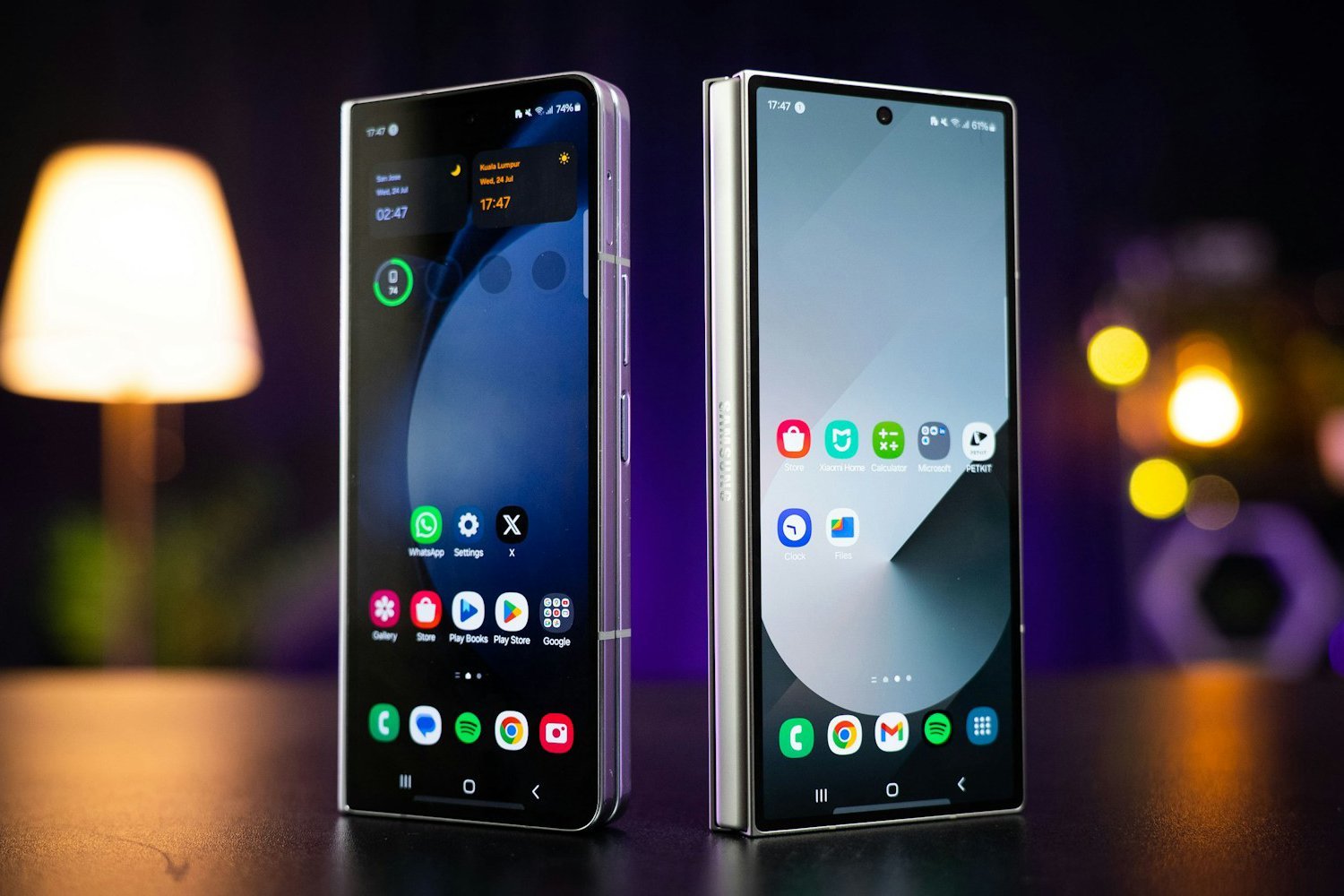
Table of Contents
Why Foldables Deserve a Dedicated UX Strategy
Smartphone usage keeps climbing, but foldable shipments are outpacing slabs five-to-one. Early adopters binge content 32 % longer and juggle 1.8× more simultaneous tasks than on standard phones. In short, designing for foldables isn’t a nice-to-have – it’s a growth lever hiding in plain sight.
Four Unique Challenges Every Foldable App Faces
- Posture Volatility; portrait, landscape, tabletop, and book modes appear in a single session.
- Hinge Occlusion; the crease can sit right on your CTA if you’re not careful.
- Two-Hand Ergonomics; thumb zones and reach maps change the moment a device unfolds.
- Multi-Window Culture; users expect a drag-and-drop workflow that feels desktop-grade.
7 Foldable UX Patterns That Regularly Double Engagement
1. Two-Pane Master/Detail Layout
Display lists on one screen half and details on the other. Email clients see read-through rates jump as high as 2× with this pattern.
2. Tabletop Media Mode
Detect a hinge angle above 110° and move video controls to the lower pane. Hands-free viewing sessions can extend by 23 %.
3. Hinge-Safe CTA Placement
Query fold bounds and offset crucial buttons at least 16 dp. Simple, but it slashes mistaken taps and bounce rates.
4. Drag Across Screens
Enable drag-and-drop from pane A to pane B – ideal for carts, kanban boards, or playlists. Internal tests show a 1.9× lift in add-to-cart events.
5. Adaptive Navigation Rail
Swap bottom navigation for a side rail when unfolded. You reclaim vertical real estate and reduce thumb travel friction.
6. State Continuity on Fold/Unfold
Persist scroll positions and form inputs via configuration-change handlers. Rage-quit incidents can drop by 38 %.
7. Multi-Window Affinity
Set resizeableActivity="true" and use flexible grids so your app shines in split-screen. Productivity apps often see 2.2× session duration when users pair them with reference content.
Developer Cheat-Sheet
| Task | Android APIs / Tools | Effort |
|---|---|---|
| Detect postures & angles | Jetpack WindowManager | 1–2 hrs |
| Simulate folds locally | Android Emulator Foldables | 0.5 hr |
| Cloud device testing | Samsung Remote Test Lab | 1 hr |
| Monitor interaction lag | Firebase Performance + INP | 1 hr |
Most teams can implement a basic foldable-ready MVP in under one sprint.
Business Upside in Hard Numbers
- +22 % retention when apps support at least two dedicated foldable postures.
- +2× discoverability in Play Store and Galaxy Store “Foldable Essentials” sections.
- -40 % task friction thanks to multi-window drag-and-drop workflows.
Foldables are still a blue-ocean segment; shipping an optimized experience today positions your brand as a category leader tomorrow.
Implementation Blueprint (EngiNerds Way)
- Audit: We run a 42-point foldability checklist on your Android or cross-platform codebase.
- Prototype: Rapid Figma-to-Compose mock-ups validate the seven patterns with real users in one week.
- Iterate: Performance tuning focuses on Interaction-to-Next-Paint (INP) so transitions feel instant.
- Launch & Learn: A phased Play Store rollout, backed by analytics dashboards tuned for posture events.
Frequently Asked Questions
How much extra time and budget should we plan for foldable support?
Expect roughly one additional design sprint (5 – 10 working days) and ≈10 % more engineering effort. Most of the lift is in layout refactors and posture testing, not net-new features.
Can a single APK really serve slabs, tablets, and foldables?
Yes. With Jetpack WindowManager (Android) or Flutter’s MediaQuery/SizeClass APIs, one binary can adapt on the fly. That keeps release ops simple and avoids store-listing fragmentation.
What KPIs should we watch after launching a foldable-ready UI?
Track Interaction-to-Next-Paint (INP) for fold/unfold latency, two-pane dwell time vs. single-pane, drag-and-drop success rate, and multi-window session length. Those metrics tie directly to retention and revenue.
Which design tools handle foldable prototyping best?
Figma’s Device Frames + Auto Layout make it easy to mock posture changes. For coded prototypes, Jetpack Compose + Accompanist or Flutter’s Foldable Simulator plug-in let you preview hinge states without real hardware.
How do we keep the experience accessible?
Maintain 4.5:1 contrast, ensure focus order doesn’t jump across panes, and provide motion-reduction toggles for hinge animations. Screen-reader tests should cover every posture.
Will the Google Play review process differ?
No special review is required, but Google’s editorial team curates “Foldable Essentials” collections. Passing their hinge-safety checks can earn prominent featuring without extra fees.
Do we need new analytics instrumentation?
Add a posture dimension to your analytics events – e.g., fold_state = folded | unfolded | tabletop. This isolates engagement lifts and helps product teams prioritise future refinements.
How do we test rare tri-fold or book-style devices?
Use the Android Emulator’s tri-fold configs for fast iteration, then rent cloud devices (Galaxy Z-series, Huawei Mate XT) for regression passes. EngiNerds typically allocates one day per device family for smoke tests.
Ready to Unfold Your Next Success Story?
Let EngiNerds Digital Agency turn complex form factors into conversion machines.
Work with us and see how quickly your engagement metrics can double.
